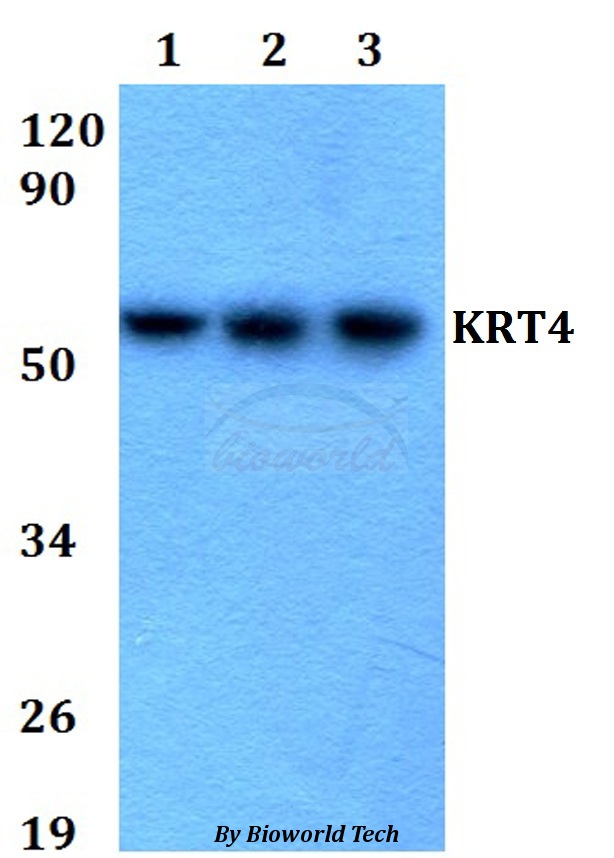Cytokeratin 4 antibody [6B10]
GTX11215
ApplicationsDot Blot, ImmunoFluorescence, Western Blot, ImmunoCytoChemistry, ImmunoHistoChemistry, ImmunoHistoChemistry Frozen, ImmunoHistoChemistry Paraffin
Product group Antibodies
TargetKRT4
Overview
- SupplierGeneTex
- Product NameCytokeratin 4 antibody [6B10]
- Delivery Days Customer9
- Application Supplier NoteIHC-P: 1:300. *Optimal dilutions/concentrations should be determined by the researcher.Not tested in other applications.
- ApplicationsDot Blot, ImmunoFluorescence, Western Blot, ImmunoCytoChemistry, ImmunoHistoChemistry, ImmunoHistoChemistry Frozen, ImmunoHistoChemistry Paraffin
- CertificationResearch Use Only
- ClonalityMonoclonal
- Clone ID6B10
- ConjugateUnconjugated
- Gene ID3851
- Target nameKRT4
- Target descriptionkeratin 4
- Target synonymsCK-4, CK4, CYK4, K4, WSN1, keratin, type II cytoskeletal 4, cytokeratin 4, keratin 4, type II, type-II keratin Kb4
- HostMouse
- IsotypeIgG1
- Scientific DescriptionIntermediate filaments are abundant cytoplasmic structural proteins in most vertebrate cells. Cytokeratins, a group comprised of at least 29 different proteins are characteristic of epithelial and trichocytic cells. Cytokeratin 4 is a member of the type II, neutralto- basic subfamily. It is a 59 kD polypeptide differentially expressed in various human tissues. Cytokeratin 4 can be detected by biochemical or immunohistochemical means in adult non-cornified squamous epithelium such as that of the superficial and intermediate cells of the esophagus, exocervix, tongue, vagina, larynx,pharynx, epiglottis, and anus as well as in the superficial cells of the cornea. In addition, its presence was demonstrated in suprabasal cells of the urinary bladder transitional epithelium, in single cells and cell groups of sweat glands and prostatic ducts and in cylindrical ciliated bronchial cells. Cytokeratin 4 may be detected in squamous cell carcinomas derived from several non-cornified stratified epithelia. Monoclonal anti-cytokeratins are specific markers of epithelial cell differentiation and have been widely used as tools in tumor identification and classification. Monoclonal anti-Cytokeratin 4 is a chain specific antibody which may facilitate typing of normal, metaplastic and neoplastic cells.
- Storage Instruction-20°C or -80°C,2°C to 8°C
- UNSPSC12352203
References
- Tait A, Proctor T, Hamilton NJI, et al. GMP compliant isolation of mucosal epithelial cells and fibroblasts from biopsy samples for clinical tissue engineering. Sci Rep. 2021,11(1):12392. doi: 10.1038/s41598-021-91939-0Read this paper
- Xie C, Li XY, Cui HG. Potential candidate cells for constructing tissue-engineered lacrimal duct epithelium: a histological and cytological study in rabbits. J Zhejiang Univ Sci B. 2015,16(11):904-13. doi: 10.1631/jzus.B1500113Read this paper
- Pavez Loriè E, Chamcheu JC, Vahlquist A, et al. Both all-trans retinoic acid and cytochrome P450 (CYP26) inhibitors affect the expression of vitamin A metabolizing enzymes and retinoid biomarkers in organotypic epidermis. Arch Dermatol Res. 2009,301(7):475-85. doi: 10.1007/s00403-009-0937-7Read this paper
- Pavez Loriè E, Gånemo A, Borgers M, et al. Expression of retinoid-regulated genes in lamellar ichthyosis vs. healthy control epidermis: changes after oral treatment with liarozole. Acta Derm Venereol. 2009,89(1):12-20. doi: 10.2340/00015555-0573Read this paper





